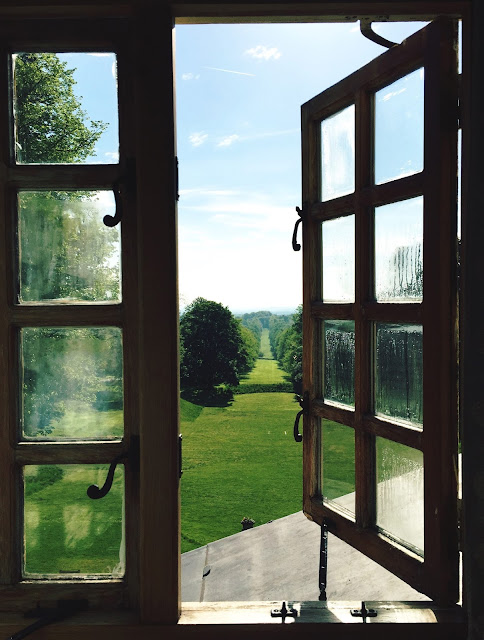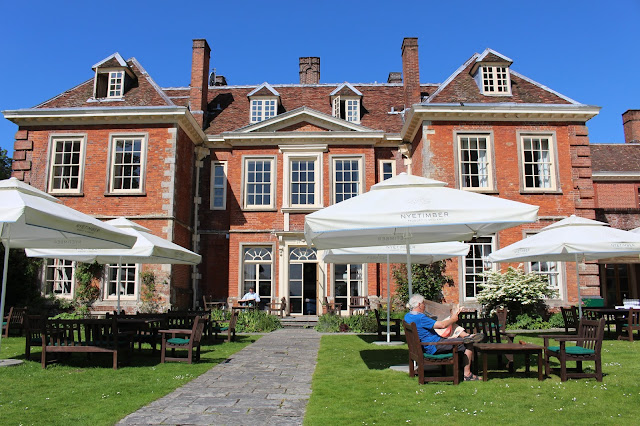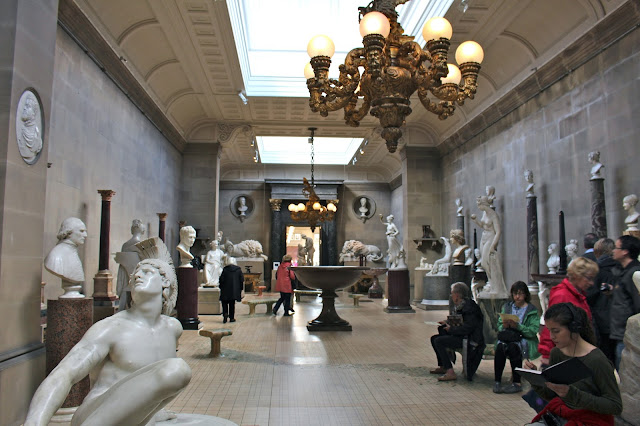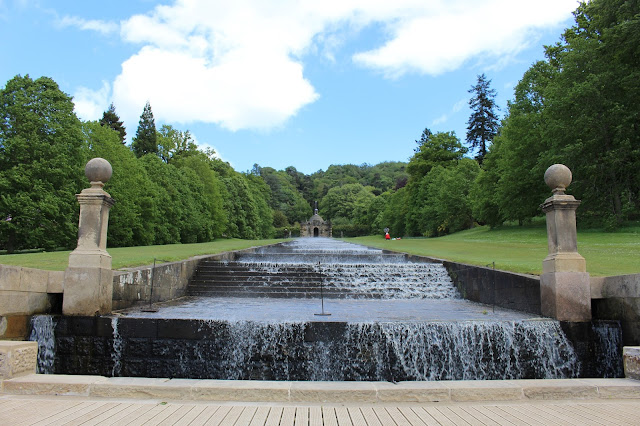This green and pleasant land, this sceptered isle, this crucible of empire and pioneer of parliamentary democracy, is the most eccentric, extraordinary and downright intriguing place on Earth. England. Tim was born here and still has lots of family and friends here so we’re visiting as well as sightseeing. But first, a few easy days in London Town.
Whoever’s been to London knows this place. Simultaneously stylish and garish, Harrods is an obligatory stop for visitors, both cash-strapped and big spenders alike. The spectacular food hall is a sight in itself. For more on Harrods and London see click here on, “A Tale of Two Cities”, our post from June, 2010.
The outstanding Victoria and Albert Museum boasts an unparalleled collection of decorative art and design with some 4.5 million objects from Britain and around the globe. The museum setting and gorgeous architecture is as inspiring as the sheer diversity and rarity of its exhibits. The rotunda chandelier, created in 2001, is by Seattle artist Chihuly, who draws on the historic techniques of the Murano glassworks of Venice.
We pop into the bookshop at Holy Trinity Brompton Church for a browse. The good folks here support the Bad Boys’ Bakery, set up in the Brixton Prison by Gordon Ramsay. His aim was to reduce reoffending rates by training bakers on the inside, and helping them find work once released from prison. Good job boys!
Tim is a member of the Hurlingham Club so whenever we’re in London we like to spend a few hours here.
Set in 42 acres of magnificent grounds, the Hurlingham Club is a green oasis in the heart of London.
Recognised throughout the world as one of Britain’s greatest private members’ clubs, it retains its quintessentially English traditions and heritage while providing modern facilities and services for its’ members. Chuff chuff, jolly good indeed I say, good fellow.
Lunch on the outdoor patio.
Watch out for peacocks in the parking lot.
We had our wedding reception here back in 2010.

En route to Cornwall we stay the night in Winchester at Lainston House, a charming 17th century country house set elegantly in 63 acres of beautiful Hampshire parkland. As you sweep into the courtyard, delicate archways and loggias frame the picture-perfect entrance and a small amble reveals a 12 century chapel ruin and pretty dovecote.

You’ve got to love a place that provides a rubber ducky for your bath.
Tim’s as happy as Larry in the garden with the Financial Times.
Onward to Cornwall. We pass Stonehenge on the way but since we’ve been here before we don’t stop.
We’re staying at the family vacation home of Tim’s niece, Nugs, her husband Ed, and their son, Max. After happy hour on the outdoor patio Ed is hungry and more than ready for the delicious dinner they have prepared for us.
The salad is such a standout Sandi asks for the recipe. The addition of roasted asparagus gilds the lily. Try it!

A magnificent sunset is the perfect ending to a perfect evening.

Today the skies look ominous but the view from our bedroom window is still beautiful.

Cornish weather is unpredictable. We had hoped to take the water taxi across the Camel Estuary from Rock to Padstow today but we’re not very inspired in the cold and drizzle.
Ed has the answer—a big, long, leisurely lunch in Rock, a once-quiet village that’s been reinvented as an uber-exclusive holiday destination.
This is more like it. Today the sun is shining showing off Polzeath in all it’s glory.
Polzeath hosts a fantastic beach and village and is one of the worlds most renowned surfing destinations.
Adorable Max is really good fun to sit next to.
This photo is for you Max, to remind you of your “meat treat”. Thank you Nugs, Ed and Max—we loved every minute and we love you!
Lincolnshire is one of the most sparsely populated corners of England—farmland unfolds over low hills and the pancake-flat Fens. It is dotted with windmills and, more recently, wind turbines. Surrounding the charming county town of Lincoln are seaside resorts, scenic waterways, serene nature reserves, stone-built towns tailor-made for English period dramas, and Tim’s twin sister Tessa and her husband Charlie, whose family has lived here for generations.
The English have the loveliest tradition of always putting fresh-cut flowers in their guest rooms.
Charlie is most pleased with his recent acquisition who many of you will recognize as the infamous, Big Green Egg.
For those of you who don’t know, the Big Green Egg is a modern-day evolution of ancient cookers, modeled on the clay vessels seen during the Chinese Qin Dynasty and then used by the Japanese in the 3rd century. Dinner is served!
But not before a little bubbly to toast family reunions.

Crumble smells something good.
Tessa and Charlie give Sandi a fine, English cookbook for her birthday. Tim’s going to benefit from this present too.
Today we’re treasure hunting with Tessa’s geiger counter. Charlie and Tessa’s house started off as a monastery for monks in the 1100s, likely in conjunction with Lincoln Cathedral, so you never know what could turn up. We’re getting a strong signal here so we start to dig.
Deeper and deeper we go.
Breeze and Crumble are getting excited now too.
Charlie’s convinced he’s going to hit the jackpot and won’t give up. He brings out his “big gun” pick axe while everyone waits with baited breathe.
Sadly, we didn’t unearth anything except an old, rusty nail so Sandi took a photo of this beautiful rose instead. Such is the life of treasure hunters.
To reward our efforts Tim treats us to dinner at The Bell at Coleby.
It’s been an exciting, tiring day for us all.

Tessa is an accomplished equestrian, and this is her horse, CB.

Nice horsey.
Tessa is also an accomplished henkeeper and introduces Sandi to the “girls”.
Broody is going through henopause and stealing everyone else’s eggs.
Today we’re at Hemswell, Europe’s largest antique center, on the hunt for easier-to-discover treasure.
Sandi’s always wanted an antique cameo.
But which one to choose?
It’s a tough decision and we run out of time so it will have to wait until next time.
We are however, going home with these six silver napkin rings.
Charlie’s taking us on a tour of the surrounding area today.
He has relatives buried in the churchyard here in Nettleham.
Their graves date to the mid-1800s.
“More tithes and offerings please people!”
Charlie’s family has a very distinguished past.
His relatives even have beautiful stained glass windows in their memory in the church.
Good-bye Charlie and Tessa! Thank you very much for everything—we love you!
Cheerio to Breeze and Crumble too!

In the glorious Peak District ancient stone villages are folded into creases in the landscape, and the hillsides are littered with stately homes and rocky outcrops that attract hordes of walkers, climbers and cavers. No one knows how the Peak District got its name—certainly not from the landscape, which has hills and valleys, gorges and lakes, wild moorland and gritstone escarpments, but no peaks.
We arrive late in Bakewell (most famous for its tart) and check into the Cavendish Hotel. It’s a stormy night so room service is on order.
Known as the “Palace of the Peak”, Chatsworth House is a vast edifice three miles northeast of Bakewell.
It has been occupied by the earls and dukes of Devonshire, and sheep, for centuries.
Inside, the lavish apartments and mural-painted staterooms are packed with priceless paintings and period furniture.
Chatsworth is home to the Duke and Duchess of Devonshire, and has been passed down through 16 generations of the Cavendish family. The house architecture and art collection have been evolving for five centuries.
The manor was founded in 1552 by the formidable Bess of Hardwick and her second husband, William Cavendish, who earned grace and favour by helping Henry VIII disolve the English monasteries. Mary, Queen of Scots was imprisoned at Chatsworth on the orders of Elizabeth I in 1569.
The house sits on 25 square miles of grounds and ornamental gardens.
If you thought this was a real violin and bow, you’d be wrong. Trompe l’oeil (French for ‘deceive the eye’) is an art technique that uses very realistic imagery to create the optical illusion that the object depicted is actually three-dimensional. In this case the painting (c.1674-1724) itself, is set into an actual door.
Not just your average solid gold vanity set.
Georgiana Cavendish (1757-1806), Duchess of Devonshire.
In the 20m-long North Sketch Gallery, columns of DNA are appearing, protruding from the wall. It's a family portrait like you’ve never seen before—the work of ceramist Jacob van der Beugel, who clad the room entirely in ceramic panels which detail the DNA sequences of the Duke and Duchess of Devonshire and their family.
Priceless, hand-painted Chinoiserie wallpaper graces the walls of the bedrooms.
The Library.
Dining Room ceiling.
Horse-drawn carts brought coal from the railway station at Rowsley, entered the garden above the Stables and took the track that went under the Cascade and on to the Coal Hole (above). From here the coal was taken in small wagons along the underground railway.
Tomorrow we’re hopping on over to the Lake District to follow in the footsteps of Peter Rabbit.
















































































































No comments:
Post a Comment